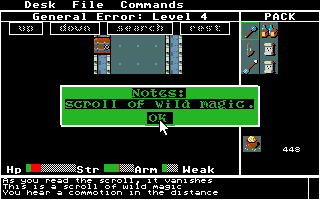Retro Replay Review
Gameplay
From the moment you step into the Dungeon of Doom, Rogue’s gameplay hooks you with its relentless challenge and strategic depth. Every turn you take demands careful thought, whether you’re deciding to inch toward a lurking monster or cautiously explore a new corridor. There’s no holding your breath in real time here—each action happens only when you press a key. This turn-based system ensures that every decision feels weighty, as pushing forward might trigger an unseen ambush or activate a deadly trap.
(HEY YOU!! We hope you enjoy! We try not to run ads. So basically, this is a very expensive hobby running this site. Please consider joining us for updates, forums, and more. Network w/ us to make some cash or friends while retro gaming, and you can win some free retro games for posting. Okay, carry on 👍)
At its core, Rogue thrives on procedural generation. The layout of each dungeon level, the placement of monsters, and the distribution of items all change with every fresh start. This means memorizing exact room patterns or monster spawns is impossible—no two expeditions are ever the same. As you descend through the three-by-three grid of rooms and winding dead ends, adaptability becomes your greatest weapon. Learning to read ASCII symbols quickly and interpret the landscape of hallways and chambers often distinguishes a triumphant run from a hasty demise.
Resource management is another pillar of Rogue’s gameplay. You’ll collect swords, armor, food rations, and magical scrolls, each represented by simple characters on the screen. Inventory space is limited, so you must weigh the immediate benefit of a superior weapon against the risk of carrying fewer healing potions. The twenty-six monster types—each denoted by its initial letter—further complicate decisions. Do you risk engaging a powerful Troll (“T”) to gain experience, or bypass it and conserve your health for the next room? These trade-offs generate adrenaline-pumping tension throughout every descent.
Graphics
Rogue’s graphics are the epitome of minimalist charm. Instead of vibrant sprites or 3D environments, you navigate through a world rendered entirely in ASCII characters. Walls are drawn with lines, doors appear as plus signs, and monsters roam as single letters. While this approach may seem dated, it grants Rogue a timeless quality and lays bare the game’s emphasis on mechanics over spectacle.
The simplicity of ASCII visuals also promotes clarity. Without flashy animations or effects, the moment-to-moment state of the dungeon is always readable. You’ll never wonder if that flicker in the corner is loot or a hidden trap. A blinking ‘@’ marks your hero, and shifting symbols reveal the approach of enemies or the glint of an undiscovered staircase. In a way, the absence of high-definition graphics frees your imagination to paint the rest of the scene, giving Rogue a surprisingly cinematic feel despite its text-based façade.
Moreover, the graphical style directly supports the procedural design. Because the dungeon is redrawn with every new game, complex tile sets would only bog down loading times or risk visual repetition. ASCII art, by contrast, adapts instantly to random map layouts, ensuring that each run feels unique. When you see a goblin (‘g’) skulking around a corner, there’s no mistaking its threat level—Rogue’s visuals, though simple, communicate information with utmost precision.
Story
Story in Rogue is deliberately sparse, a classic hallmark of early dungeon crawlers. You assume the role of an unnamed adventurer with one clear objective: retrieve the Amulet of Yendor and escape alive. There’s no elaborate backstory or cutscenes, only the looming promise of vast riches—and even greater peril—waiting in the depths below. This stripped-down narrative approach places the emphasis squarely on the emergent tales that arise from gameplay itself.
As you delve deeper into the dungeon, encountering leprechauns that steal gold, fainting at the sight of a ghost, or narrowly evading a giant snake, you craft your own heroic saga. Every near-death experience, dramatic comeback, or unlucky arrow to the knee becomes part of your personal legend. The text log—detailing discoveries and combat results—serves as a makeshift chronicle, letting you recount your triumphs and tragedies with relish.
Despite its brevity, the story framework effectively conveys a sense of ancient mystery. References to mystical scrolls, enchanted rings, and cryptic altars hint at a world beyond the dungeon’s immediate threats. The absence of explicit lore compels you to imagine who once looted deeper levels, what dreadful entity guarded the Amulet, and whether countless fallen explorers litter the floors you traverse. In this way, Rogue’s minimalist tale proves more evocative than many overproduced narratives.
Overall Experience
Playing Rogue today feels like stepping into gaming history. It’s easy to be dazzled by modern roguelikes boasting streaming-quality graphics and voice-acted NPCs, but Rogue’s raw mechanics still deliver an unmatched thrill. Every descent into the Dungeon of Doom reinforces why Rogue has endured for decades: it’s unforgiving, endlessly replayable, and brilliantly designed around tension and discovery.
If you crave an experience that tests your strategic mettle, Rogue won’t disappoint. The loop of exploring, fighting, and leveling up is addictive, and the specter of permadeath keeps every decision fraught with consequence. Beginners should prepare for steep learning curves—missteps in food consumption or misreading an ASCII goblin can end your run in an instant. Yet this very difficulty is what makes each success so rewarding.
Ultimately, Rogue offers a pure, unembellished dungeon-crawling odyssey. It may lack modern conveniences like auto-mapping or user-friendly tutorials, but for those willing to embrace its austere style, it stands as an enduring testament to gameplay over glitz. Whether you’re a veteran of the genre seeking its origin story or a newcomer thirsty for a challenging adventure, Rogue remains a must-play classic that shaped the roguelike games we enjoy today.
 Retro Replay Retro Replay gaming reviews, news, emulation, geek stuff and more!
Retro Replay Retro Replay gaming reviews, news, emulation, geek stuff and more!









Reviews
There are no reviews yet.